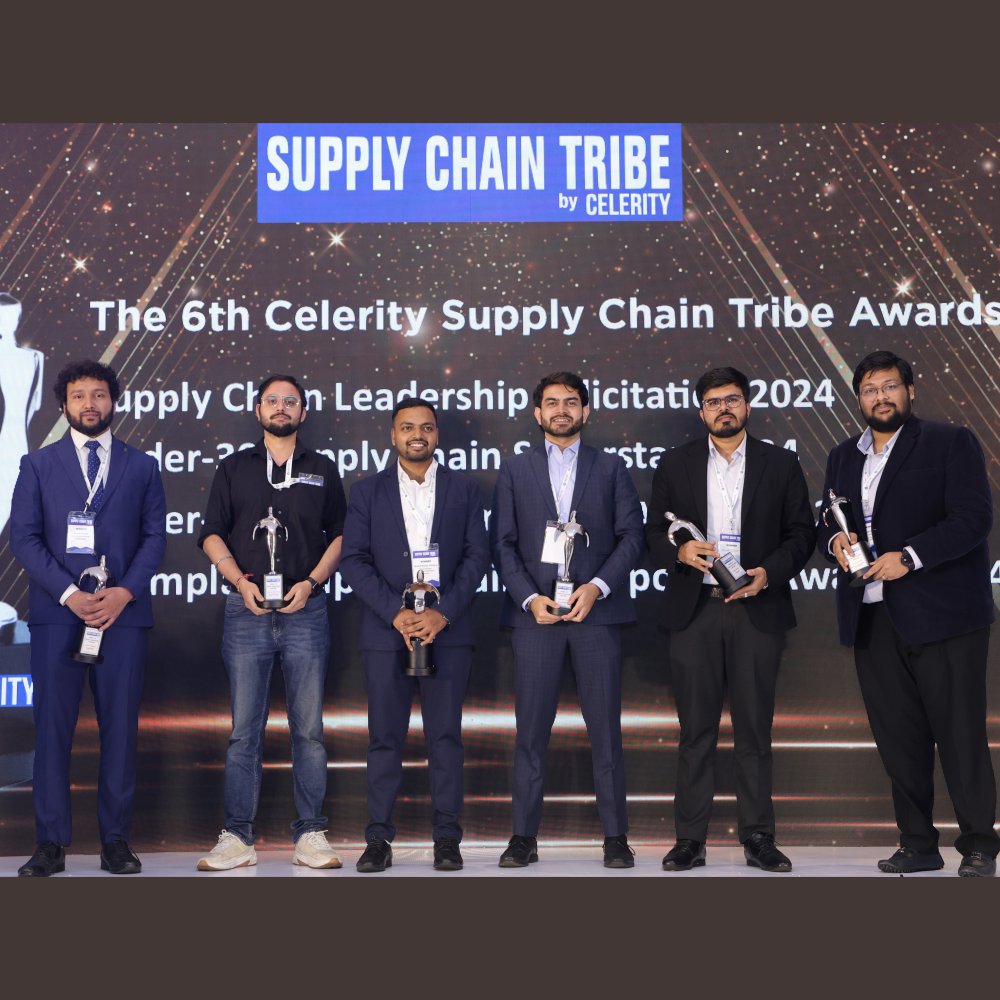Here’s to showcasing the groundbreaking innovations and initiatives driven by our Under 30 Celerity Supply Chain Super Stars 2024. Carefully selected through a rigorous nomination process by a distinguished panel of senior jury members, these awards have established a formidable league of future supply chain leaders. Their achievements and innovations underscore the excellence of our strict and detailed judging criteria.
Aditya Sharma, Senior Operations Manager, Zum Services Inc.
Integrating insights from the electrification movement and leveraging vehicle-to-grid (V2G) technology, my project aimed to address environmental concerns head-on.
Acknowledging the International Energy Agency’s projection that 60% of new cars will be electric by 2030, and the trend of major companies electrifying their fleets, I embarked my team on a mission to electrify our school buses, with a goal for a fully electric fleet by 2027. This transition not only aligns with the increasing consumer shift towards EVs but also positions us at the forefront of sustainable transportation.
Our initiative leveraged V2G technology, enabling our electric buses to not just consume power but also supply it back to the grid, enhancing grid resilience and reducing the need for fossil-fuelled power plants. This bidirectional charging capability transforms our buses into mobile distributed energy resources, contributing positively to the power grid, especially during peak demand hours.
We have been able to secure grants at the Oakland location in California towards this and are working to get this implemented at Branford, CT by next year with our First EV bus launch on the East Coast. The outcome of this initiative is a testament to our commitment to a decarbonized future, offering cleaner, more sustainable transportation options, and setting a new standard for environmental responsibility in the Supply chain and transportation sector. Securing the V2G and EV Infrastructure requires working with multiple supply chain partners and clearing houses with permissions and hence it is very challenging and rewarding at the same time.
Ankur Joshi, Senior Consultant – Supply Chain Transformation, aioneers Technologies India Pvt. Ltd.
Many organizations rely on manual or excel-based forecasting methods, leading to low accuracy, stockouts, high inventory, and low service levels.
Challenges Faced: Educating customers about advanced forecasting processes; addressing data quality issues; managing the high cost of cloud storage; and dealing with unorganized client processes.
Approach: We conducted supply chain exploration using data analytics to identify issues and designed target processes (TO BE) and built a business case with ROI and timelines.
Implementation: We understood the client processes and data flows, finalized TO BE processes, configured the SaaS platform to meet client requirements. We conducted System Integration Testing (SIT) and User Acceptance Testing (UAT), went live with the platform and provided hyper care support during the initial phase.
Outcome: The entire exercise improved forecasting accuracy. Automated history cleansing and machine learning algorithms enhanced forecasting accuracy, reducing stockouts. Features like exception-based planning and forecast overrides with manager approval streamlined collaboration. Reduced inventory levels and improved service levels led to cost savings for organizations. Automated processes minimized manual intervention, increasing efficiency and productivity. Clients gained a competitive edge by adopting data-driven decision-making in their supply chain operations.
This SCM innovation significantly impacted organizations by enabling data-driven decision-making, optimizing forecasting accuracy, and streamlining collaboration, ultimately leading to improved operational efficiency and cost savings.
Apaar Khurana, GM & Regional Head –ISC, Delmar Total Transportation
We were facing the issue of underutilisation of Console Containers.
Approach: Current movement is based on selling in the FOB market (Destination-controlled). Due to volume reduction amid Covid, utilization of containers decreased.
Implementation: Our efforts attracted volume from prepaid market consigned to the same destination to have better console utilization. We met different customers to understand shortcomings and offered solutions as B2B to only wholesalers in the space. We also procured new space in the Nhava Sheva region to run operations separately and attract new customers. Trust building and marketing took 45 days to achieve the first shipment.
Outcome: We started flow of prepaid volume with current volume to increase utilization by 25%. Profitability increased by 40% due to better utilization compared to the earlier volume. I led new project team post above implementation focused only on neutral LCL space - built GTM strategy, identified key personnel from industry to lead different verticals within LCL space.
Gaurav Dhaudiyal, Central Category Planner, Pernod Ricard India
White glue (Adhesive) SKU of 1 kg (1x50) pouch packs are packed in a HDPE container and sold to market. This pouch is used in certain markets where customer requires 1 kg packs for small usage. We wanted to reduce the cost of serving the product to the market.
Challenges faced: We couldn’t change the product recipe to a low-cost recipe in line to maintain the brand quality. We couldn’t use some other container or low-density pouch packs because the chance of in transit damage was high as observed in a pilot run using shipper boxes and low-cost pouch packs.
Approach: We aligned all the supply chain stakeholders right from the IT, plant team till the market sales in-charge and brainstormed for the idea and approach. We evaluated the cost benefit by directly serving the customers from the nearest manufacturing unit in a milk run and bringing the empty HDPE containers back to the unit because these containers could be used 21 times before its quality deteriorates as per quality checks. Rs107 per 50 kg was reduced using this.
Implementation: We did a market pilot and closed the gaps after which we started this in phase wise manner for all markets. All the stakeholders were aligned, and the customers were also informed.
Outcome: We were able to achieve savings of Rs107 per 50 kg which led to margin increase in the product, resulting in better discount to customer. We were also able to enhance environmental sustainability by reusing HDPE plastic; the entire process was JIT and resulted in improved customer satisfaction.
Gaurav Dubey, Deputy General Manager – Supply Chain & Network Design, Kuehne Nagel
When COVID-19 hit, initially demand dropped to a bare minimum, owing to widespread store closures for Jubilant Foodworks. Being in the highly perishable food industry, imminent threat of significant expiries was at dawn. An immediate response was essential. First, it was critical to identify which all items (~ 300+) at which locations (12) were critical and needed urgent attention and which could be deferred for another 15 days.
To address this, I designed a simulation model that tracked all food products and their batches (as 1 SKU at 1 location can have 10 different batches which makes 10 expiry dates of the same item), accounting for varying expiration dates within a single SKU. Then model incorporated forecasted sales at the SKU-plant/warehouse-week level, adapting to the changing landscape as stores began reopening and forecasts fluctuated significantly at week level. We did multiple forecast simulations considering factors such as the absence of offline sales, the rise in online sales, and the phased reopening of stores in tier-1 and tier-2 cities. These scenarios helped us project final expiries and potential monetary losses in best- & worst-case scenarios. Detailed scenario briefings were conducted with the executive committee.
With the expiry data in hand, a strategy needed to be devised. Challenges included varying batch distributions and demands across the 12 locations, and transit times between 1 to 9 days for moving batches between locations. Given these constraints, efficiently planning movements, across the network to maximize value was too tedious a manual task and complex as well, leaving spots for errors.
An optimization model was then designed to determine which batches of which item should be relocated to which locations within the required timeframe to prevent expiries and ensure cost-effectiveness. This approach, involving fewer than 25 movements, saved expiries worth Rs7 crore. The design, the planning, the execution, the importance of time, the stakeholder dynamics, and the stakes involved made this a great learning episode. I was honoured with the ‘Gold Award’ for my contributions to the business during the pandemic.
Rahul Pathak, Supply Chain Manager, Finolex Industries
One pivotal SCM innovation I led was the deployment of a real-time supply chain visibility platform. The pressing issue we confronted was the lack of transparency and coordination throughout the last-mile supply chain, resulting in inefficiencies and delivery delays. Challenges included disparate systems and data silos among stakeholders, hindering effective communication and decision-making. Our approach entailed close collaboration with cross-functional teams to identify pain points and requirements for the platform. Extensive market research guided our selection of a suitable technology solution capable of real-time tracking of shipments, inventory, and transportation routes.
During implementation, we prioritized fostering a collaborative culture and provided comprehensive training to stakeholders on utilizing the platform efficiently. We also addressed data security concerns by implementing robust encryption and access controls. The outcome was transformative. We achieved significant reductions in delivery lead times, empowered by real-time insights facilitating proactive decision-making and issue resolution. Optimization of inventory holding costs and enhancement of operational efficiency were evident across the supply chain. Moreover, the platform fostered trust and collaboration among internal teams and external partners, enhancing overall supply chain performance and customer satisfaction.
This innovation not only tackled immediate challenges but also laid the groundwork for ongoing digital transformation and innovation within the organization. It demonstrated our team’s adeptness in identifying improvement opportunities and leveraging technology to deliver tangible value.
Satyug Kejriwal, Director – Logistics & Operations, Network Carrying Company Pvt. Ltd.
Faced with inefficient Supply Chain Management (SCM) processes, escalating operational costs, and the challenge of balancing optimal service levels with environmental sustainability, my team and I spearheaded a transformative digitization and technology-driven initiative. The problem statement centered on the need for a comprehensive solution to address these multifaceted challenges.
The challenges encompassed the complexities of cost management, service level improvement, and the pressing need to reduce carbon emissions within our supply chain. We identified the need for an innovative approach that could simultaneously enhance service levels, reduce operational costs, and mitigate our environmental impact.
Our solution involved the integration of an advanced Enterprise Resource Planning (ERP) system, aimed at improving visibility and communication across the supply chain. This not only streamlined internal processes but also contributed significantly to reducing operational costs by 11.8%. To address the challenge of service level improvement and cost reduction, we incorporated an optimizing tool into the ERP system.
Implementation involved meticulous mapping of lead time matrices, cost structures, and carbon emissions at various supply chain touchpoints. The optimizing tool dynamically adjusted routing and operational parameters, resulting in a remarkable 18% improvement in service levels and a concurrent 30.4% reduction in our carbon footprint.
This innovation not only optimized service levels and reduced costs but also positioned our organization as a technological leader in sustainable supply chain management. It addressed the complex problem statement, overcame operational challenges, and resulted in a transformative leap towards operational efficiency, cost-effectiveness, and environmental sustainability.
Tarleen Kaur, Logistics Program Manager, American Consumer Electronics MNC
I have been fortunate enough to lead global projects to improve business processes. In achieving the desired strategic goals, I utilize my entrepreneurial vision, technological understanding, and exceptional relationship management to foster revenue growth, cost savings, and improved productivity. Apart from my core specialization in Innovation & Product Management, I also bring Operational Leadership, Strategic Planning, and Agile Techniques to the table. I see a tremendous scope in the amalgamation of supply chain and technology as we move along the growth trajectory.
Yalini Chaturvedi, Manager - Demand Planning, Nestle India Ltd.
I have led various initiatives and change management activities impacting both topline and bottom-line, to ensure the market share continues to grow with high profitability. I have also been responsible for the effective production planning, deployment, and inventory management. During this period, I coordinated with all stakeholders and optimized the network throughout the value chain. I have also successfully done Events management. Events management (product/promotional change management) is a complex process from ideation to final implementation and requires the alignment of several stakeholders – across marketing, product development, manufacturing, supply chain and MIS - to ensure success. In my role as demand planner, I have also helped improve demand planning accuracy, along with my team.

Categories

Magazine Editions






















